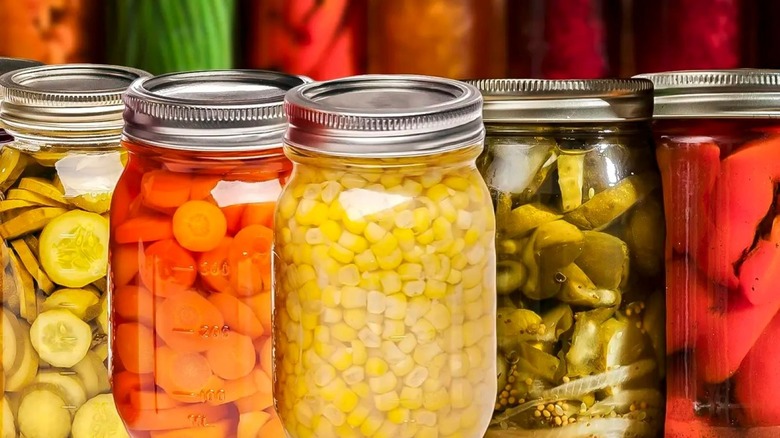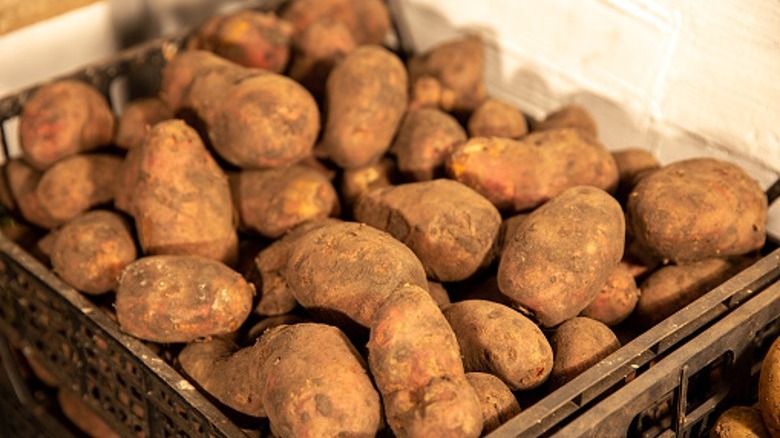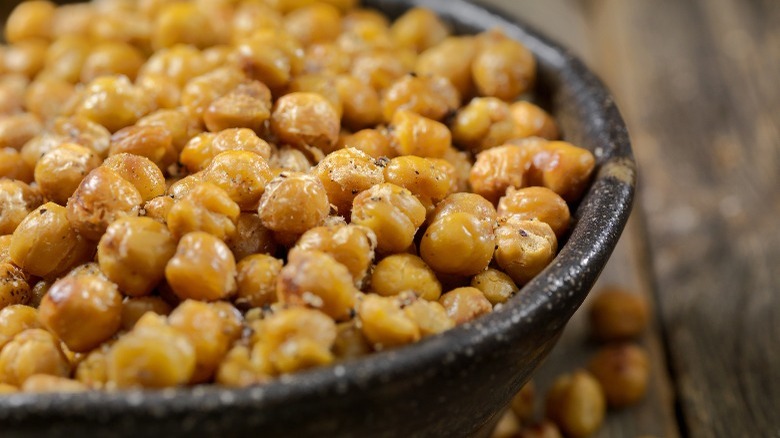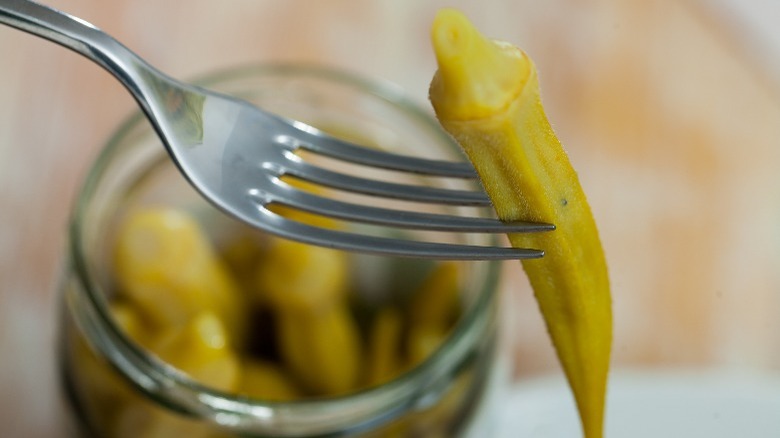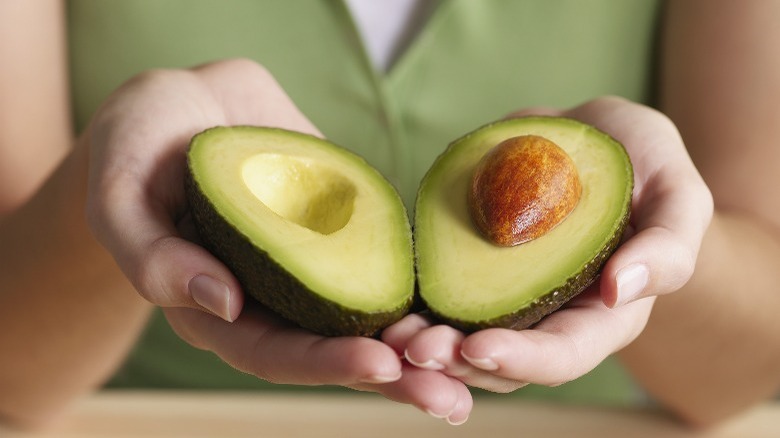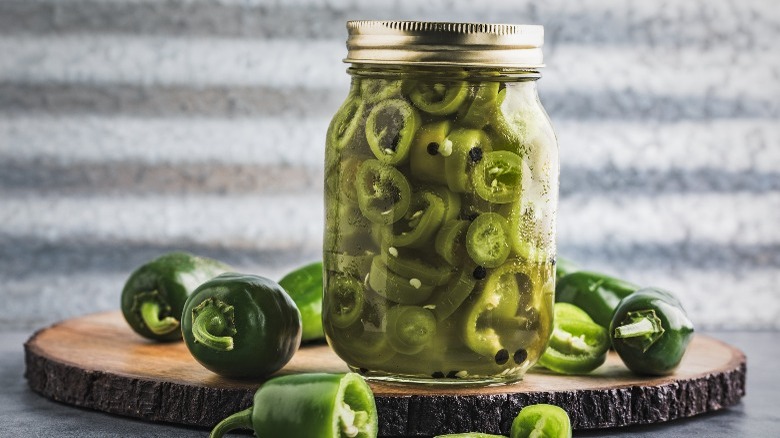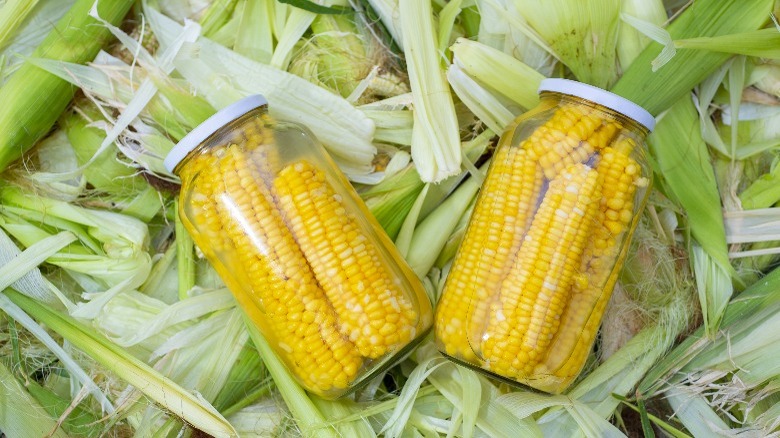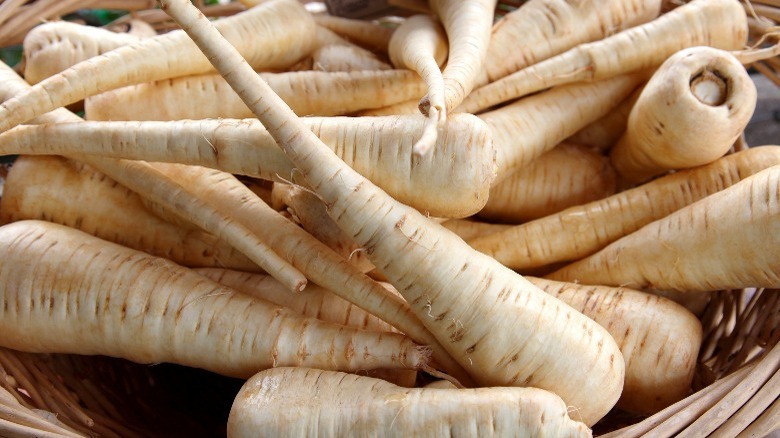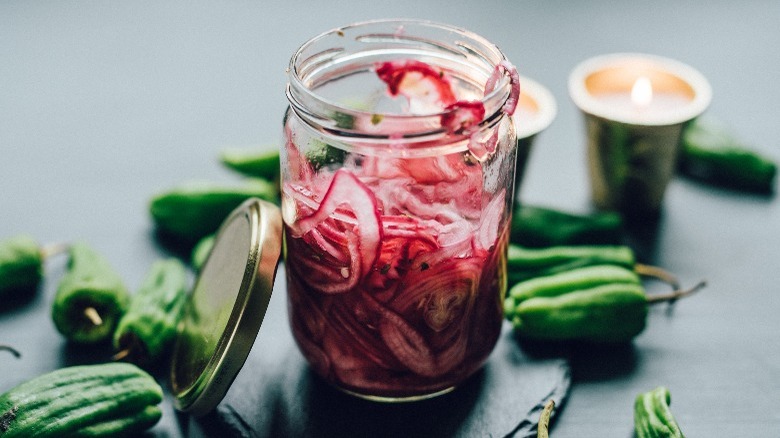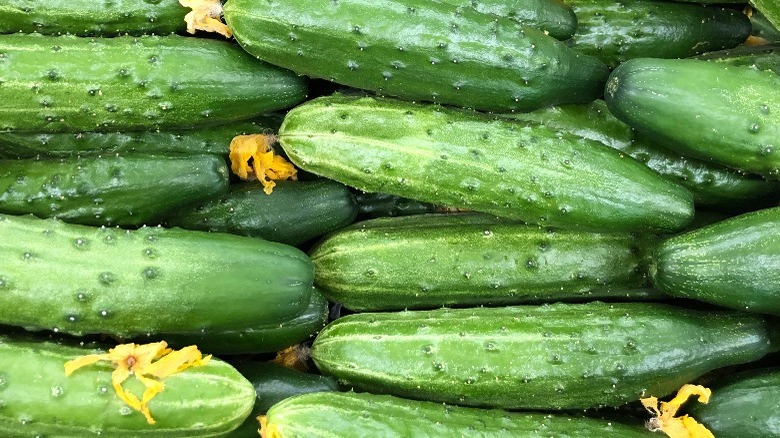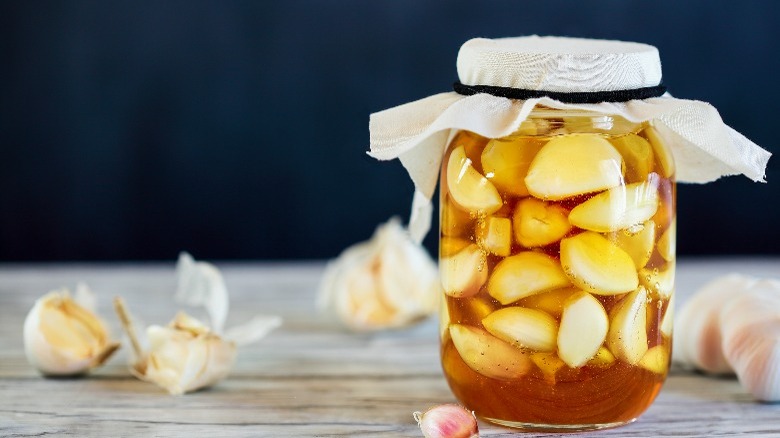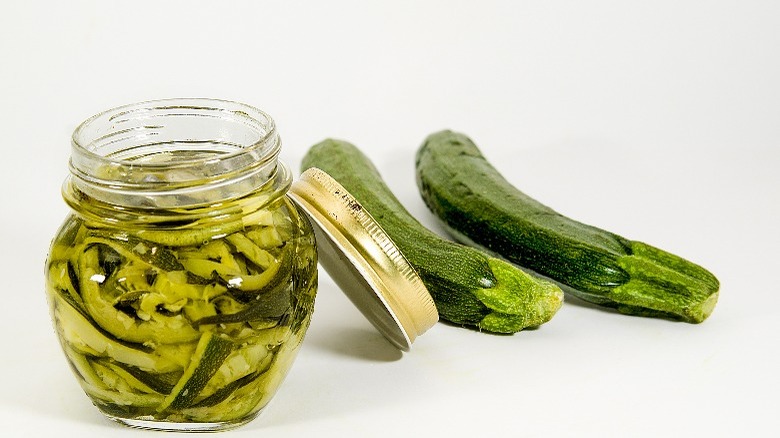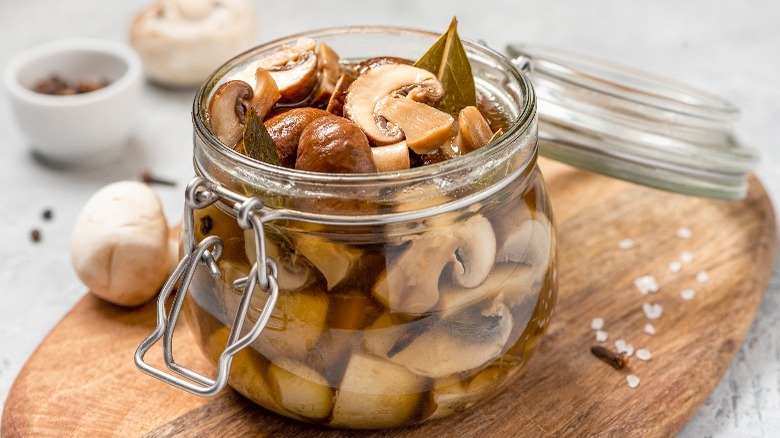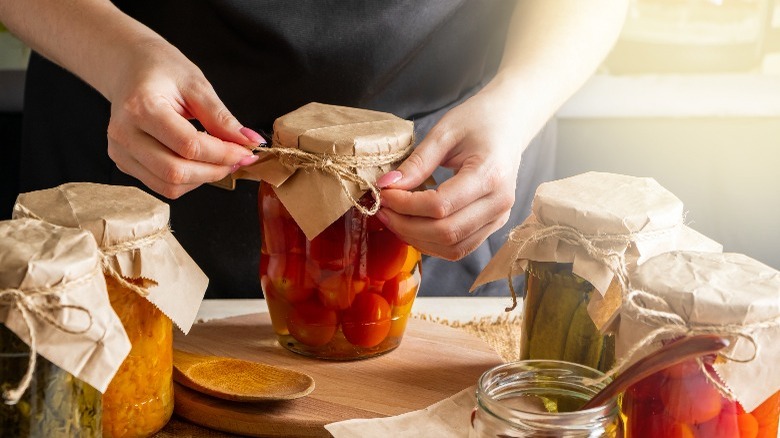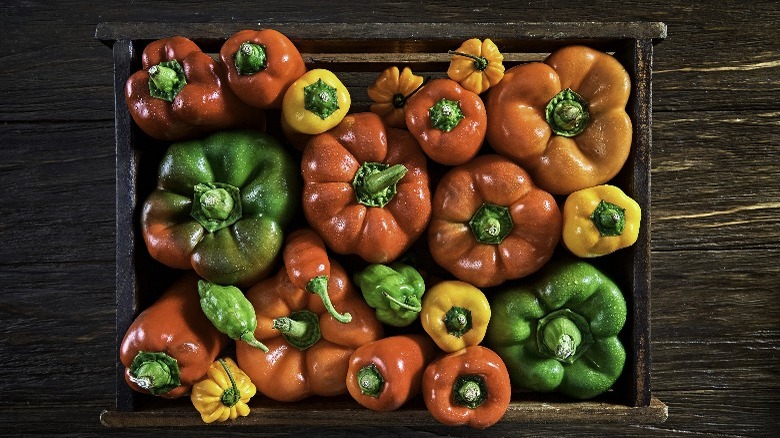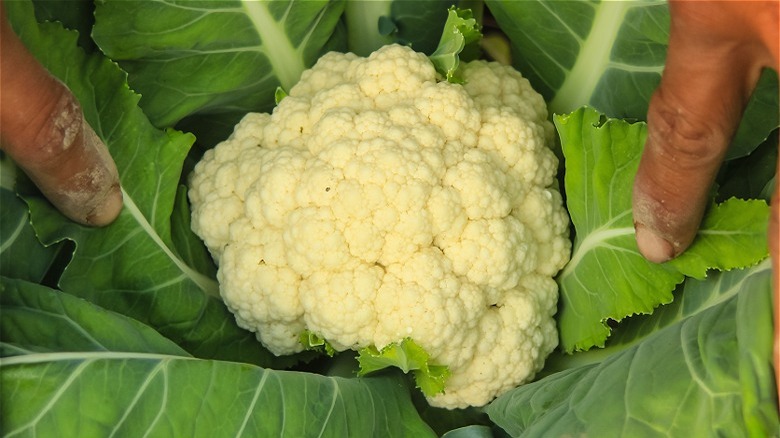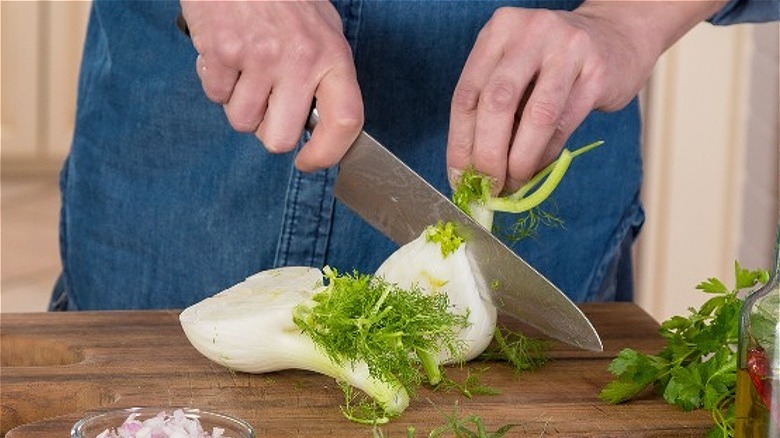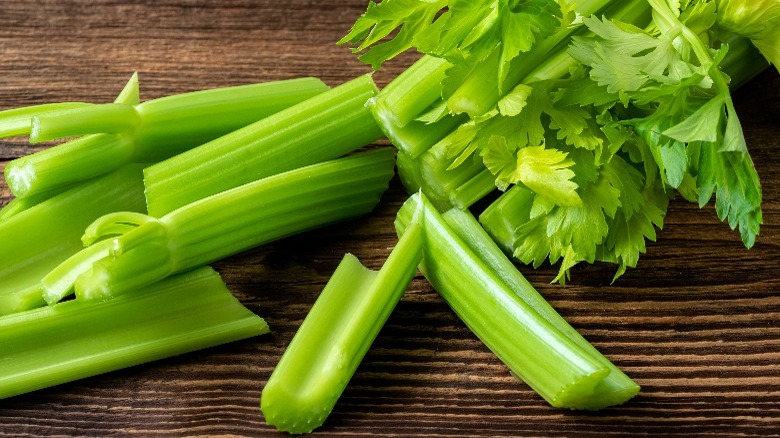Vegetables You Need To Start Pickling ASAP
Pickling your vegetables is one of the easiest ways to make a flavorful side dish or topping for any meal. It infuses your vegetables with a satisfying tang, as well as the layers of flavor from any spices and herbs you add to the brine. It's also a pretty foolproof technique. Just dump your ingredients in a jar, put a lid on it, and wait for the magic to begin.
With that said, you'll want to make sure you're using the right pickling method. If you want a colorful blend of pickled vegetables to serve as a summer side, look for "quick pickle" recipes. These usually use vinegar to provide tanginess and can be ready to eat in hours. This is technically more of a marinade than a true pickle, but it's still delicious and ideal for dishes you want to eat immediately.
If you're stocking up on vegetables to eat months from now, you should look for fermentation or canning recipes. These slower pickles take anywhere from three days to three months to start developing their signature tanginess. That's because the tanginess develops as yeast and bacteria inside the brine. These components break down the naturally occurring sugars in the vegetables. They release acids and flavor compounds as they do, while also slightly softening the texture of the vegetable. Whether you want to try quick or slow pickling, here are all the different vegetables you should be using.
Potatoes
Pickled potatoes make an incredible topping when diced and served on tacos, salads, or sandwiches. They also add brightness when used as the base of a potato salad recipe. It's all the starchy goodness of a potato with the tanginess of a pickle, what's not to like?
To make them, peel and boil your preferred potatoes to soften them. Slice them into fry-shaped sticks, so they fit more readily into a jar, or cook them a little longer so that you can mash them for fermented mashed potatoes. For a quick pickle, once your potatoes are prepped, add them to a jar with vinegar and your favorite whole spices and herbs. Sea salt, peppercorns, and cumin seeds are all good options. But anything you'd normally season your potatoes with works here. Let this marinate overnight. For fermented potatoes, add your prepped potatoes along with any herbs and spices to a sterilized jar and cover with brine – a saltwater mixture with at least one tablespoon of salt per quart of water. Then, cover the potatoes. Let that ferment on your counter for at least five days.
You can follow a similar process with other root vegetables, like beets, turnips, rutabaga, and radishes. When boiling the root vegetables, just adjust the cooking time based on the texture you want. Keep in mind that fermenting will slightly soften the vegetables, too. If you want more crunch, keep the boiling to a minimum.
Chickpeas
Chickpeas, or garbanzo beans, are another great candidate for pickling. You can use pickled chickpeas just as you would use their non-pickled counterparts. Toss them over a salad. Cream them into silky hummus. Add them to a stew or curry for extra texture and bulk.
You can use either dry or canned chickpeas for both quick pickles and ferments. But if you start with dry chickpeas, cook them first to soften them. Let your quick pickle marinate overnight. But if you're fermenting, let the jar sit on a counter for 10-14 days. When you're ready to put them in a jar, consider adding minced garlic, turmeric root, or lemon peels for added flavor. You can also try making an achaar, a kind of pickled vegetable mix with variations found all across Southeast Asia. In India, for example, chickpeas are pickled with mango, carrot, or tomato and seasoned with garam masala or turmeric.
You can also pickle any other legume, including all of your favorite beans, snap peas, lentils, or edamame. Make a colorful mix of pickled beans or peas for a satisfying side dish loaded with protein, fiber, and, if you fermented it, probiotics.
Okra
Okra is used widely across Asian and African cuisines as well as in the Southern United States. While it can be used to thicken a stew or round out a mixed vegetable side dish, it's often just enjoyed on its own, either raw, deep-fried, or pickled.
Add pickled okra to a charcuterie board or pop one in your next bloody mary. Better yet, just pop off the lid and eat them straight out of the jar. Their hollow interior makes for a satisfying snap when you bite into them, making them the perfect delivery vehicle for that briny pickle flavor. When pickling okra, you can use a classic dill pickle recipe with fresh dill, garlic, and a dash of sugar added to your brine. Add sliced jalapeños or crushed red pepper flakes to add a layer of heat to the mix.
There's no need to cook the okra ahead of time, either. Instead, bring the brine to a boil without the okra in it. The moment it starts to boil, pour it into your okra-packed jar. Let your quick pickle rest in the fridge overnight, or store your fermented okra on the counter for at least 10 days.
Avocados
Avocados probably aren't the first thing that comes to mind when you think of pickles. But it's an underrated candidate for your pickling experiments. Think about it. Avocados only seem to stay perfectly ripe for about five minutes. So pickling them is the perfect way to give yourself more time to use those avocados.
Plus, you can start the pickling even with an unripe avocado. The fermentation will soften them, so there's no need to wait for that rare period of ripeness. Just slice the avocado into strips, then put it in a jar with vinegar or brine. You can even add some of your favorite guacamole ingredients to round out the flavor profile: garlic, onion, cilantro, red pepper flakes, and maybe even a slice or two of lime. A quick pickle will be ready overnight and fermented avocados will be ready in as soon as three days. If they were still fairly unripe when you started pickling, you might want to give both versions an extra day or so to soften up a bit more.
Jalapeños
If you want a snack-worthy vegetable that packs some heat, you should pickle jalapeños or your other favorite hot pepper. They're great to munch on by themselves, but they're also incredible on top of nachos, burgers, and hot dogs. They're flavorful enough to pickle on their own, but they also make a fantastic addition to any other vegetable you might want to pickle. Pickle them with carrots and onions for an easy escabeche.
You can also take it up a notch and puree your fermented hot peppers to make a hot sauce. If you know you're using them for hot sauce, remember to adjust the heat level by removing the seeds from some or all of the peppers before you ferment them. If you forget or miscalculate, you can add diced bell peppers when pureeing to dilute the heat, while preserving the texture. Experiment with the flavor profile of your hot sauce by preparing a few jars of fermented peppers with different aromatics and spices. Throw in a few carrot slices for some earthiness or minced garlic for added brightness, for example. When it's done fermenting — in about one week — strain the brine into a clean jar to use for your next batch and puree the pepper and vegetable mixture until it's a smooth sauce.
Corn
Corn can be pickled on the cob, but the most convenient way is to remove the kernels and just pickle those. That way, you can easily scoop out a spoonful or two to sprinkle on salads, nachos, or soups. For best results, load the brine with seasoning like hot pepper flakes, cumin, and black pepper as well as aromatics like garlic, onion, cilantro, jalapeños or even lemongrass. That way, each kernel will be a flavor bomb, enhancing every bite of the dish it garnishes.
Corn doesn't take long to pickle, either. A quick pickle will be ready in about 12 hours, although the flavor will continue developing for the next three to four days — so, if you have leftovers, it will just keep getting better every day. Fermented corn is ready to eat after three days, but you can let it ferment at room temperature for up to two weeks, depending on how much tanginess you want.
For an even heartier and more interesting taste and texture, use hominy instead. This is white, dried field corn (also known as maize) that's been soaked in an alkaline solution in a process called nixtamalization. The process creates a puffier, chewier kernel with a more complex flavor profile. You can pickle it the same way you pickle yellow corn kernels and use it wherever you'd use yellow corn.
Parsnips
Parsnips are the forgotten cousin of the carrot. While both are sweet, parsnips have a hint of pepper and nuttiness to them that you won't find in a carrot. Pair that natural flavor profile with a tangy brine and you've got the perfect ingredient to add new layers to a summer salad, enhance a gazpacho, or put a creative twist on potato salad, using parsnips instead of potatoes.
Parsnips are firm, so you might want to cook them a bit before adding them to the jar, either by sautéing or boiling them for a few minutes to soften them. If you want to keep them raw, slice them into thin matchsticks for a crunchy snack. Let your quick pickle rest for at least a day and leave fermented parsnips to develop on the counter for 10 days.
They're flavorful enough to pickle on their own, but if you want to elevate them even further, try adding ginger, cinnamon, cardamom, cloves, black pepper, or turmeric. Parsnips go great with a lot of the spices you'd use on sweet potatoes or winter squashes.
Onions
One of the best advantages of pickling onions is that the process mellows it. This makes it much easier to add the great flavor of onion to raw dishes like sandwiches or salads. Plus, it adds a zip of tangy vinegar or brine.
Since onions are so aromatic, they're definitely a candidate for pickling on their own, but feel free to mix in other aromatics for an even more nuanced and flavorful condiment. Garlic, shallots, and leeks are all great vegetables to mix in. You also can't go wrong with just about any herb.
Another perk of pickled onions is that they don't need much time at all. For a quick pickle, all you really need is an hour for the sharpness to mellow. But leave it to rest in the fridge overnight to let any other flavors you added meld. Meanwhile, fermented onions will be ready in about five days, but you can let them keep developing for up to two weeks if you want them extra tangy.
Cucumber
The cucumber is the king of pickles. It's the vegetable that first comes to mind for a lot of people when they hear the word pickle. It's definitely earned its rank. Pickled cucumber is a perfect snack, the perfect topping to brighten a burger or hot dog, the perfect pop of zest in a potato salad, and the perfect garnish for any barbecue plate.
While they can be pickled by themselves, they often have garlic, fresh dill, and pickling spice — a blend typically made of whole mustard seeds, allspice, cloves, peppercorns, cardamom, coriander, and bay leaves. A quick pickle recipe is ready to eat in just an hour. When fermenting, the time depends on how much crunch and tang you're looking for. A typical half-sour pickle — the crunchier, milder pickle variety — takes about a week to ferment. For a sour pickle — the chewier, tangier kind — you should let them ferment for anywhere from two weeks to two months. The longer you let them ferment, the chewier and tangier they get.
Garlic
Keeping a jar of pickled garlic in the fridge is one of the best food hacks you can incorporate into your routine. You can use it just as you would use raw garlic — in pasta, stir-fries, or salad dressings, for example. But, like onions, the pickling process mellows out the sharpness of garlic so you can use it to add a garlicky kick to raw dishes as well. The best part is, when you have a jar of pickled minced garlic, you can add garlic to any meal without having to peel and mince garlic. If you tend to use garlic in most of your dinners, that's a huge time-saver.
If you're making a quick pickle, the garlic will be mellowed and ready to eat in about an hour. Fermented garlic will be ready in about three days, but you can let it keep fermenting for months. The longer garlic ferments, the richer and sweeter it gets.
Squash
Zucchini, butternut, and squash are versatile ingredients. Most varieties have a fairly mild flavor that easily adapts to whatever seasoning you add to it. So when you start pickling squash, feel free to play around with the herbs and spices you add to the brine. A classic option is to pickle pumpkin with a pumpkin spice blend. Butternut squash would also pair well with a traditional pumpkin spice blend. Both of these sweeter squashes also taste great with a little heat added from garlic or chili peppers. For squashes that aren't as sweet, try a traditional dill pickle recipe where you swap out the cucumber for a blend of zucchini, summer squash, and spaghetti squash.
When making a quick pickle, you might need to blanch your squash for a few minutes before pickling to soften them a bit. Then, let them marinate for at least four hours. If you have the time, one or two days will make them even more flavorful. When fermenting, you don't need to blanch the squash, but you should chop it into thin wedges or matchsticks. It will be ready to eat after five days on the counter but you can let it ferment at room temperature for up to two weeks, before moving it to the fridge.
Mushrooms
Pickled mushrooms make it possible to keep this delicious but quick-to-spoil ingredient on hand at all times. You can use this method on pretty much any kind of edible mushroom. While raw mushrooms can spoil in a matter of days, quick pickled mushrooms will keep in the fridge for up to a month, and fermented pickles can be kept for about six months. That gives you a lot more time to use up your mushrooms.
But it can also transform them into an even more delicious earthy umami bomb for your plates of pasta, salads, and sandwiches. They're also a great addition to hot dogs or burgers if you really want to impress your friends at your next barbecue. Plus, they're super easy to make with no cooking required.
Just prepare your brine, add your favorite herbs and spices, and pour it over your mushrooms. Slice them first if you want them to be ready to eat right out of the jar. Quick pickled mushrooms can be eaten in just two hours — but they taste best when left to rest in the fridge for one or two days. Fermented mushrooms are ready in about three days.
Tomatoes
Tomatoes are already an acidic ingredient, so fermenting them for extra tang is a natural choice. The soft flesh of tomatoes also makes them perfectly suited to absorbing the brine you put them in. This is a great way to take your pasta sauce game to the next level. Add the herbs and spices you typically use in your sauce to the pickle brine, so you can season your tomatoes from the inside out before cooking your sauce. Just remember to slice your tomatoes in half first, so the soft inner flesh is exposed to the brine.
Since they absorb flavor so well, a quick pickle recipe for tomatoes can be ready to eat in just an hour — or less if you cut them into thin slices first. They can keep in the fridge for up to one month. Fermented tomatoes will take at least 10 days if left whole, or about five days if sliced.
Bell peppers
Pickled bell peppers are another delicious snack to keep on hand. They're mildly sweet, satisfyingly salty, and wonderfully tangy all in one bite. Bell peppers also don't much need help beyond a basic salt or vinegar brine, but you can experiment with your favorite herbs and spices to add a little extra zing.
Whatever brine you choose, just remove the core and slice the peppers into strips to stuff into jars before pouring in the brine. A quick pickle recipe will be ready in about a day — and keep in the fridge for up to two weeks — while fermented bell peppers will be ready after about five days and keep for about six months. Either version tastes great in a sandwich, on a burger, or in a salad. They also add great flavor and color to a charcuterie board or as a pizza topping. You can even add a few slices to your bagel with cream cheese to liven up your morning breakfast.
Cauliflower
Cauliflower has a mild nutty flavor that makes it a great side for many dishes, but it can be a little bitter when raw. Pickling helps mellow at that bitterness and pull out the naturally sweet and nutty undertones. While a quick pickle recipe can be eaten after two hours, it's really better to give cauliflower at least a day to marinate in its brine, since it's such a firm vegetable. Chop the florets up into smaller pieces if you want to speed this process up a bit, but still aim to make it at least a day ahead of time.
Some similar rules apply to other cruciferous vegetables like Brussels sprouts and broccoli. Cabbage also falls into this category, so follow the same general time frames for any sauerkraut or kimchi you're making. While these firm vegetables might seem like they would need a longer ferment time, they actually taste best when the pickling process is stopped early because their own flavor is relatively mild. The shorter time also keeps them nice and crunchy.
Fennel
You might not know it from the look of it, but fennel is a relative of carrots. Like carrots, it has an earthy sweetness to it that adds depth to a dish. But it stands out for the undertones of licorice and mint, which give it a distinctive flavor profile that makes a soup or salad extra special.
Fennel's flavor is so complex and unique that it hardly needs any help from added herbs or spices when brining. But if you want to pull out any particular dimensions of its flavor, add ingredients that are similar to that flavor. For a stronger punch of licorice, add some star anise pods or tarragon. To play up the mint, add mint, parsley, or basil. To bring out its sweetness, try pickling it with pear slices, cranberries, cherries, or orange zest. For more earthiness, combine it with radish, celery, mushrooms, oregano, juniper berries, or peppercorns.
You can eat quick pickled fennel after 12 to 24 hours and it keeps in the fridge for up to two weeks. Let fermented fennel sit at room temperature for at least two weeks. Then store it in the fridge for up to six months.
Celery
Celery may not spoil quickly, but plenty of people have found themselves in a situation where they end up with a whole bunch of celery when the recipe only calls for one or two stalks. The rest of the celery just sits in the fridge for ages, not quite dying but definitely losing its freshness. Pickling your neglected celery can turn the rest of that bunch into a more exciting ingredient.
Chop it into small pieces as you would when making a mirepoix or soup. Then, wash it thoroughly, because celery has a knack for clinging to the dirt. From there, follow a similar process as you would for any other quick pickle or ferment. Celery works great with a classic dill pickle brine. If you shred it, you can also make a sauerkraut or kimchi where the shredded celery takes the place of cabbage. Whatever flavors you add, let a quick pickled celery rest in the fridge for at least a day, but two is better — and store it for up to a month. Fermented celery also needs more time relative to other vegetables. It should ferment for at least two weeks, but three or four weeks will allow it to develop even more flavor. It should keep in the fridge for about six months.
